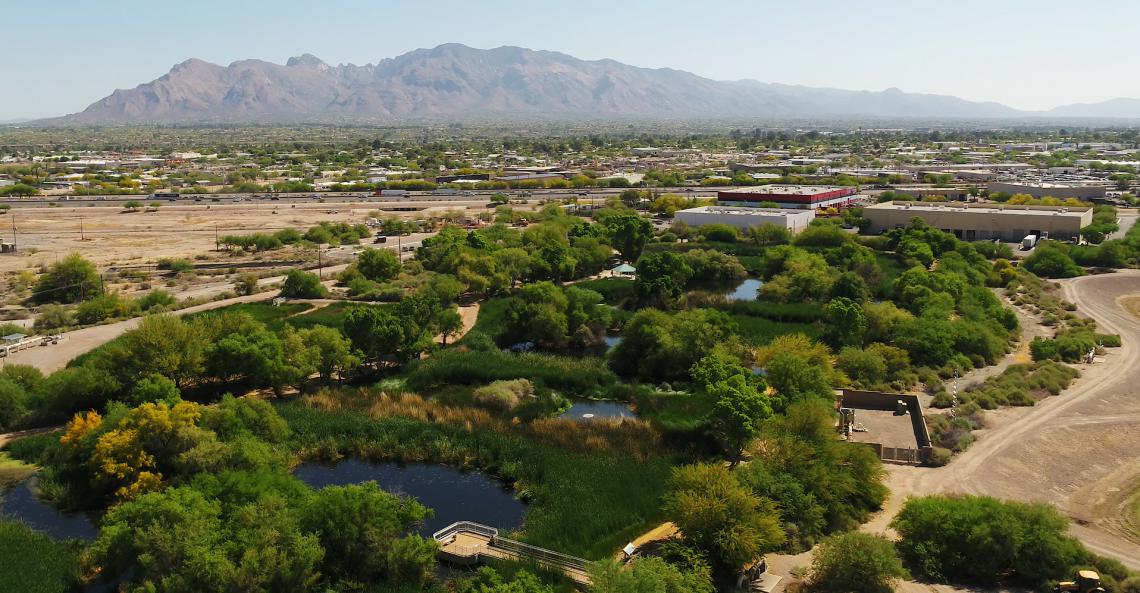Field Snapshot: Recycled Water Could Hold Clue to Harmful Algal Blooms
Video examines clue about toxic algal blooms in the recycled water of a constructed wetland in Tucson.
It’s a tried and true movie script. Caped heroes racing against the clock, rushing to solve a puzzle and save the world. But in this scenario, the good guys (and girls) donned lab coats and latex gloves, wielding pipettes to conduct molecular analysis. And this puzzle is invisible to the human eye.
This story is part of a series showing the people behind the science in our department tackling today's big environmental challenges.
Watch: An environmental microbiologist deciphers deadly algae
Investigating more frequent toxic algal blooms
Not every day is an action movie scene for research scientist Jean McLain in the University of Arizona Department of Environmental Science. But an unanticipated discovery in a constructed desert wetland provides a thrilling lead to an environmental challenge affecting ponds, lakes and waterbodies all over the world.
McLain investigates what causes naturally-occurring cyanobacteria in surface waters to suddenly and inexplicitly produce deadly toxins and form harmful algal blooms. Also called blue-green algae because they are aquatic and photosynthetic, this bacterial genus is naturally abundant in freshwater, as well as in brackish and marine systems.
Cyanobacteria can be relatively harmless until environmental trigger(s) causes them to produce toxins that are released into the water. These toxins have the potential to kill animals and harm humans, especially the immuno-compromised, targeting our hepatic or neurological systems. We don’t know much about these triggers, although scientists have identified the genes in specific cyanobacteria that suddenly “turn on” to control toxin production.
Film Page 3_highlight_3.jpg

Finding out more about what in the environment causes algal blooms to become dangerous comes at comes at a crucial point. Scientific studies, like a recent one in Nature show how toxic algal blooms in freshwater are increasingly common and thought to cost the United States more than $4 billion annually.
“It would give us a way to warn water managers that the conditions are right for the toxin production, so they can close the beaches or not use a certain source for drinking water.” explains McLain.
Currently there is limited warning when and if a bloom becomes dangerous, including Arizona beaches. Because it takes hours to analyze water samples for the presence of toxins and toxin-production genes, beach managers and water treatment plant operators are left to scramble and warn the public of any potential danger.
But how McLain came to this discovery is a bit of a plot twist—a scientific hypothesis proven wrong.
An unexpected discovery
A few summers ago, McLain and her students sampled water in the Sweetwater Wetlands, a constructed wetland and wildlife haven on the west side of Tucson. They hypothesized that residual nutrients in the highly treated recycled municipal wastewater used to create the wetlands might correlate to the presence of toxin-production genes.
Using molecular analysis, they found no trace of any toxins or the specific genes in the water samples. However, a nearby groundwater-filled pond, used as a “control site” for this study, had high levels of toxin-producing genes – a completely unexpected finding.
To establish that this discovery wasn’t an anomaly, McLain worked with environmental science graduate student, Robert Lynch, to collect more samples and conduct more analyses over the next few years. But no toxins or toxin-producing genes ever appeared in ponds that were filled with recycled wastewater, even when algae blooms occurred.
“There’s something about recycled water that is inhibiting the toxin production but still allowing the same levels of cyanobacteria.” says Lynch.
According to McLain, this is the first time something has been found in the water that seems to inhibit the “triggering” of toxin production. It could be a residual chemical in the recycled water, an environmental factor like plentiful sunlight, or perhaps competition from other algae present in the wetland.
Identifying what exactly is in the recycled water will require much more research and in-depth analysis, but McLain is hopeful about this small and unexpected finding could be a first step to deciphering deadly algal blooms. Now, it's time for some other characters to enter the scene to crack the next part of the code.



